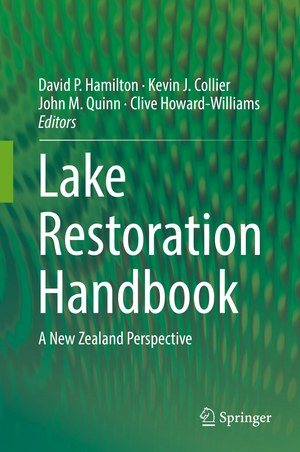Lake Restoration Handbook: A New Zealand Perspective
Editat de David P. Hamilton, Kevin J. Collier, John M. Quinn, Clive Howard-Williamsen Limba Engleză Hardback – 7 feb 2019
Preț: 1566.79 lei
Preț vechi: 1910.72 lei
-18% Nou
Puncte Express: 2350
Preț estimativ în valută:
299.80€ • 313.86$ • 248.07£
299.80€ • 313.86$ • 248.07£
Carte tipărită la comandă
Livrare economică 08-22 aprilie
Preluare comenzi: 021 569.72.76
Specificații
ISBN-13: 9783319930428
ISBN-10: 3319930427
Pagini: 756
Ilustrații: XIX, 599 p. 133 illus., 123 illus. in color.
Dimensiuni: 155 x 235 mm
Greutate: 1.09 kg
Ediția:1st ed. 2018
Editura: Springer International Publishing
Colecția Springer
Locul publicării:Cham, Switzerland
ISBN-10: 3319930427
Pagini: 756
Ilustrații: XIX, 599 p. 133 illus., 123 illus. in color.
Dimensiuni: 155 x 235 mm
Greutate: 1.09 kg
Ediția:1st ed. 2018
Editura: Springer International Publishing
Colecția Springer
Locul publicării:Cham, Switzerland
Cuprins
1. Context for restoration.- 2. Modelling for catchment management.- 3. Modelling water quality to support lake restoration.- 4. Agricultural catchment restoration.- 5. Nutrient budgets in lakes.- 6. Physical processes for in-lake restoration: destratification and mixing.- 7. Flocculent and sediment capping for phosphorus management.- 8. Control of invasive aquatic plants.- 9. Management of non-indigenous lacustrine animals.- 10. Restoration of native fish in New Zealand lakes and reservoirs.- 11. Indicators of ecological integrity.- 12. Biodiversity genomics: monitoring restoration efforts using DNA barcoding and environmental DNA.- 13. Automated high-frequency monitoring and research.- 14. Remote sensing of water quality.- 15. Empowering indigenous community engagement and approaches in lake restoration: an Āotearoa-New Zealand perspective.- 16. Applying citizen science to freshwater ecosystem restoration.- 17. Reflections on Lake Restoration.
Notă biografică
David Hamilton is Deputy Directory at the Australian Rivers Institute at Griffith University. He held the Bay of Plenty Chair in Lake Restoration at the University of Waikato, New Zealand for 15 years and led a major lake restoration programme designed to provide the underpinning research to address algal blooms and incursions of invasive fish. This programme provided the impetus for the current book. Hamilton is an associated editor on two international journals and has led several special issues of scientific journals. He has also held a position at the University of Western Australia where he developed and applied models of lake water quality.Kevin Collier is a freshwater ecologist at the University of Waikato who has worked across the science-management interface for over 30 years. He has previously co-edited books synthesising ecological knowledge of New Zealand freshwater invertebrates (2000) and the country's longest river, the Waikato River (2010). He is associate editor on two international journals.
John Quinn is an aquatic ecologist who has been Chief Scientist for Freshwater and Estuaries at NIWA since 2015. Over the previous 20 years, he led cross-institute, interdisciplinary, research programmes on river, lake and estuary restoration, river ecosystems and land use interactions and managing forest harvest impacts on streams. He has been a guest editor of two special issues of scientific journals focused on the outputs of these programmes.
Clive Howard-Williams is currently Chief Science Advisor (Natural Resources) at New Zealand's National Institute for Water and Atmospheric Research. He has published widely on freshwater ecosystems from tropical to polar regions, and has led research programmes on wetland, lake and estuarine ecosystems. He has also been involved in freshwater consultancy work on freshwater restoration. Clive has been the guesteditor of several books and journal special issues related to aquatic ecology.
John Quinn is an aquatic ecologist who has been Chief Scientist for Freshwater and Estuaries at NIWA since 2015. Over the previous 20 years, he led cross-institute, interdisciplinary, research programmes on river, lake and estuary restoration, river ecosystems and land use interactions and managing forest harvest impacts on streams. He has been a guest editor of two special issues of scientific journals focused on the outputs of these programmes.
Clive Howard-Williams is currently Chief Science Advisor (Natural Resources) at New Zealand's National Institute for Water and Atmospheric Research. He has published widely on freshwater ecosystems from tropical to polar regions, and has led research programmes on wetland, lake and estuarine ecosystems. He has also been involved in freshwater consultancy work on freshwater restoration. Clive has been the guesteditor of several books and journal special issues related to aquatic ecology.
Textul de pe ultima copertă
Lakes across the globe require help. The Lake Restoration Handbook: A New Zealand Perspective addresses this need through a series of chapters that draw on recent advances in modelling and monitoring tools, citizen science and First Peoples’ roles, catchment and lake-focused restoration techniques, and policy implementation. New Zealand lakes, like lakes across the globe, are subject to multiple pressures that have increased in severity and scale as land use has intensified, invasive species have spread and global climate change becomes manifest. This books builds on the popular Lake Managers Handbook (1987), which provided guidance on undertaking investigations into, and understanding lake ecosystems in New Zealand. The Lake Restoration Handbook: A New Zealand Perspective synthesises contemporary issues related to lake restoration and rehabilitation, integrated with social science and cultural viewpoints, and complemented by authoritative topic-area summaries by renowned scientists and practitioners from across the globe. The book examines the progress of lake restoration and the new and emerging tools available to managers for predicting and effecting change. The book will be a valuable resource for natural and social scientists, policy writers, lake managers, and anyone interested in the health of lake ecosystems.
Caracteristici
Integrates leading technologies, models, indigenous knowledge, and citizen science on lake restoration Shows how these contemporary lake restoration tools may be applied practically for solutions to water quality problem Provides inter-disciplinary understanding across the natural and social sciences Addresses diffuse pollution, invasive species and climate change Synthesises information on lake restoration at the local (New Zealand) scale and provides an international context for this information With contributions from leading authorities across the globe
